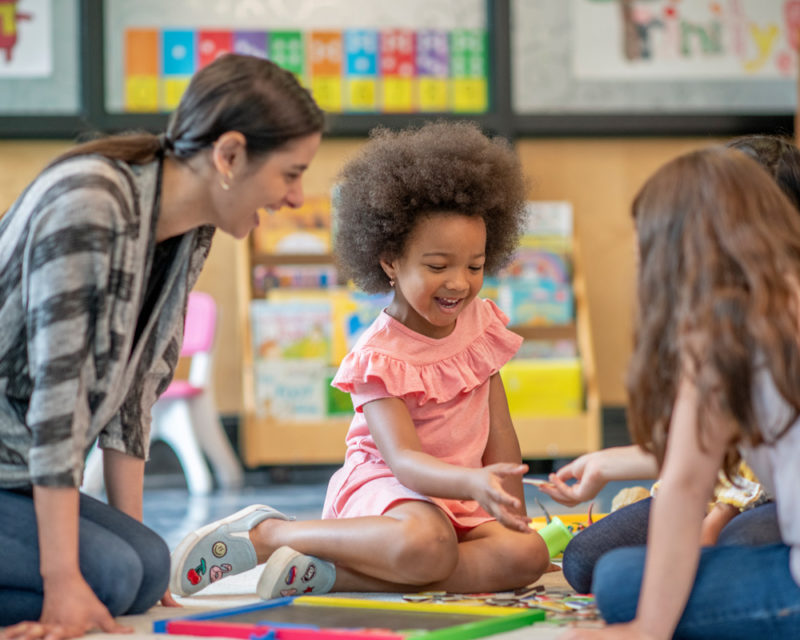Great Ideas
SEL & Elementary Math: Parallel Learning Paths
In the wake of learning interruption brought on by the pandemic, we’re seeing clear signs that students are struggling to re-adjust to the rhythms of the classroom. Many teachers are reporting significant behavioral issues as they interact with students who are inattentive, disruptive, or anxious. Every teacher has faced less than optimal learning conditions in the past, but today the challenges seem magnified. What can we do to address this issue and help foster a positive learning environment? Now more than ever, the answer lies in building students’ social-emotional skills.
Social-emotional learning (SEL) is divided into five core competencies—self-awareness, self-regulation, responsible decision-making, relationship skills, and social awareness. Math class is a perfect place to practice SEL, since many of the skills needed for social-emotional health are also needed for success in math. As we build confident mathematicians, we are also helping students become well-adjusted social beings. And research shows that students with strong social-emotional skills have a better attitude towards learning and do better academically.
Following are just a few of the ways you can use social-emotional learning to guide your students along their path to mastering math.
Help Students Build a Positive Math Identity
Far too many students, and perhaps some teachers as well, believe that you are either born with math ability or you are not. The students in your class may also think that boys are naturally better at math than girls, but research shows this just isn’t true. Every student can do well in math given the appropriate support. It’s important that all of the students in your class believe that they can succeed at math, and equally important that they know you believe they can learn. When you praise students for their thinking and ask them to share their strategies, they begin to own their learning and become more confident in their ability to do math, while also practicing self-awareness and self-management.
To help determine where your students are on their path to a positive math identity, we’ve created a brief Math Identity Survey for Younger Students and one for Older Students . Ask students to complete this survey (or help them do so) at the beginning of the year and again several times throughout the year. The survey will not only allow students to better understand their feelings about math, it also gives you a basis for helping them overcome any negative feelings they might have. You’ll be able to help students help themselves by understanding their strengths, identifying areas for improvement, and charting their progress throughout the year.
Reward Students’ Perseverance
Even students who say they find math “easy” are going to encounter math problems that require a bit of persistence. We need to help all students realize that success in math comes from hard work and perseverance, not natural aptitude.
One way you can help your students build perseverance is by recognizing effort. In math, it is often how we get to the solution, rather than the answer itself, that is more important. Call attention to your students’ process—their strategies, tools, and collaborative efforts—to show them how hard work produces results. When students believe they can tackle complex problems, they build a positive mindset and persevere through difficulty, practicing self-regulation, self-awareness, and responsible decision-making.
Celebrate Students’ (and Your) Mistakes
Some of your students may be anxious about math, fearful of getting the wrong answer or being made to look foolish in front of their classmates. When students are anxious, they may disconnect from the learning experience, which can lead to boredom and misbehavior. But math is a field where practitioners often explore multiple approaches before determining the most elegant solution. And frequently there are multiple ways to solve any given problem.
By establishing a classroom environment that rewards risk-taking and recognizes mistakes as learning opportunities, you allow your students to see that mistakes aren’t something to fear, but rather a way to stretch their thinking, discover what went wrong, and ultimately arrive at creative solutions. A willingness to share ideas and listen respectfully to other perspectives (even when mathematically incorrect) allows students to improve as mathematicians at the same time they’re practicing responsible decision making, social awareness, and relationship skills.
Promote Collaboration
In the real world, math is often worked on by teams, sometimes over long periods of time. Having students work in pairs or small groups allows them to learn from each other as they work towards a solution. Sometimes it’s easier for students to grasp difficult concepts when they’re able to hear other students’ thinking. We’ve all celebrated that moment when a student suddenly has a breakthrough because a peer used just the right language and imagery to explain an idea. And when students teach each other, they build confidence even as they cement their own learning.
By working together, students also learn that everyone struggles — an experience that can help foster perseverance in the face of potential roadblocks. Furthermore, as students explore and debate various approaches, they hone their listening skills even as they’re advancing their problem-solving skills. It’s a classroom win-win.
Provide Time for Reflection
So much content, so little time. With everything we want to convey to students before year-end, we may be tempted to reduce the amount of time students spend on reflection. But allowing them this opportunity helps them improve their reasoning and make important connections between concepts.
When you encourage students to reflect on their missteps, it cements the idea that mistakes are a natural part of learning math. Invite your students to write down how they’re feeling about what they’re learning. Even on those days they’re finding math difficult, remind them that it’s worth working toward a solution. And on those days when the math just flows, celebrate the moment by reminding them that math can be fun. We all need this type of reinforcement, especially as we re-learn the rhythms of the in-person classroom!




